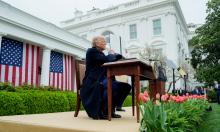Iraqi ministers in Najaf
Iraqi government ministers have held talks in Najaf with the Shiite spiritual leader, Grand Ayatollah Ali al-Sistani, two days after he brokered an end to fighting in the holy city. The five ministers from the interim Iraqi Government flew into Najaf from Baghdad in two US Blackhawk helicopters. Their convoy then drove through streets littered with mangled vehicles and mortar shells, past shattered and bullet-marked buildings to the Imam Ali shrine. The delegation met Ayatollah Sistani for about 20 minutes inside a house in Najaf's Old City, informs BBC Five Iraqi ministers visited battle-scarred Najaf on Saturday and discussed plans for rebuilding the holy city after three weeks of fighting that killed hundreds and drove oil prices to record highs. They drove through a shattered urban landscape, inspected the city's Imam Ali shrine and held talks with Iraq's most revered Shi'ite leader, Ayatollah Ali al-Sistani, who brokered a deal to end the clashes. Fighting between the Mehdi Army militia of rebel cleric Moqtada al-Sadr, who had been holed up in the shrine during their uprising, and U.S. and Iraqi forces ended on Thursday when Sistani returned after medical treatment in London to Najaf. "We have come to Najaf to consolidate the peace settlement we reached and to congratulate Sistani," Minister of State Kasim Daoud, who led the delegation, told Reuters. The ministers arrived outside Najaf in two Black Hawk helicopters and were driven through streets littered with wreckage and ammunition into its old city in a convoy led by police cars with sirens wailing. After inspecting the shrine -- the holiest in Shi'ite Islam -- Daoud said it was now free of weapons. He said the government hoped to reopen it to the public within 10 days. The ministers held a 20-minute meeting with Sistani to discuss the government's plan to rebuild Najaf and to restore water, electricity, sewage and hospital services. YNTimes published that in a single moment last week, all the mystery and contradiction surrounding Moktada al-Sadr, Iraq's rebel cleric, came into focus. It was near midnight Thursday, and the 50-odd reporters following the fighting here were hustled from their hotel by the local police and gathered for a press conference in the courtyard of a home where the Grand Ayatollah Ali al-Sistani, the country most powerful Shiite leader, was staying. Just as one of Ayatollah Sistani's aides stood to announce that a peace deal had been struck, Mr. Sadr, the man most responsible for the bloodshed, scurried out the front door, across the lawn and into the street. And then he was gone. The moment seemed to encapsulate the conflicting currents that have made Mr. Sadr, and his relationship to the Iraqi and American governments, so hard to fathom. It was Mr. Sadr, after all, whose Mahdi Army began the current round of bloodletting by attacking a police station earlier this month after the Iraqi police arrested one of his aides. It was Mr. Sadr who had turned the Imam Ali Shrine, one of the holiest sites in Shiite Islam, into a fortress from which he dared the government and the Americans to expel him. And it was Mr. Sadr, facing an indictment for the murder of a rival cleric, who had mocked the Iraqi government's efforts to arrest him. Yet for all of that, the burden of announcing the tentative peace accord had fallen to Ayatollah Sistani, the country's most revered religious figure. Mr. Sadr was allowed to dash out the front door. The kid-glove treatment of Mr. Sadr here, after days of fighting that left hundreds of Iraqis dead, points up the dilemma faced by American commanders and Iraq's new leaders. As much as both groups would like to capture or kill Mr. Sadr - and there is no doubt that they would - neither the American military nor Iraq's American-appointed government feels politically strong enough to get away with it.
Read earlier news stories by PRAVDA.Ru
Subscribe to Pravda.Ru Telegram channel, Facebook, RSS!





